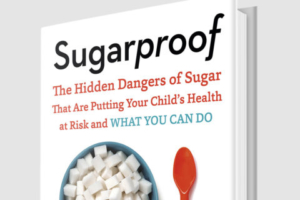A USC children’s health expert offers practical solutions to cure our sweet tooth.
(Originally posted at USC News.)
By Eric Lindberg
Saying no to crying kids in the supermarket candy aisle is an all-too-familiar scene for many parents. Good luck explaining obesity and diabetes risks to a screaming toddler.
And even if parents avoid the shelves of chocolate and peanut butter cups, they might not realize that sugary foods are everywhere. They’re hiding all over the store, even in seemingly healthful options.
When children’s health expert Michael Goran, PhD, began investigating sugar-heavy diets and their effects on kids, he was stunned: More than two-thirds of all packaged foods contain added sweeteners. Why does that matter? His research has found links between kids’ high-sugar diets and problems with sleep, learning and emotional health, not to mention serious conditions like diabetes and fatty liver disease. Goran, a pediatrics professor at the Keck School of Medicine of USC and Children’s Hospital Los Angeles, knew he had to educate people about the sugar bombs lurking in the grocery aisles.
The result: Sugarproof, a book he authored with nutrition educator Emily Ventura MPH ’07, PhD ’09. It outlines the science behind the dangers of sugar for children’s health. It also helps parents set limits on sweetened foods and drinks — and find low-sugar snacks for kids. Here’s what he says about the lessons he learned and how families can cut back on sugar.
What might surprise us about sugar in our diet?
We found kids and adults are eating not only more sugar but also different types of sugar. We found that fructose was much higher in beverages and juices popular among kids. There’s been a switch in the sugar source away from glucose. At the same time, research is showing that fructose is more detrimental to children’s development. It goes well beyond the common understanding of the dangers of sugar, which is all about calories and weight gain.
How does sugar affect children’s health and development?
Studies show a negative impact on academic performance, learning and memory. Children experience metabolic outcomes like fatty liver disease, diabetes, heart disease and inflammatory conditions like asthma, acne and even gout. And then there are digestive issues because of the effects of sugar on the gut microbiome and gut function.
Isn’t it natural for children to love sugar?
Babies are born with a built-in preference for sweetness. It’s there for evolutionary protection to favor breast milk, which is sweet, and to favor sweet foods that are a good source of energy while avoiding potentially harmful foods. But that system wasn’t designed for our current food supply. It was designed for survival. Now we have grocery stores where 70% of packaged foods has added sugar and 80% of kids’ foods has added sugar. We have this imbalance between what we were designed to do from an evolutionary perspective and the realities of our current environment.
What are some of your strategies to limit high-sugar diets?
We describe how to talk to kids and get them motivated. You can’t just show up one day and say, “No more sugar!” That would backfire quickly, and it’s not sustainable. Our overall strategy is not to eliminate sugar, because it is an important part of food culture and celebration. We’re much more moderate, and the goal is to raise kids who can learn how to self-regulate.
One thing we talk about is identifying hidden sources of sugar. There are many different forms — there are 200 names for sugar — and they are hidden in 70% of processed foods. If we can be aware of that and substitute it with alternatives that don’t have added sugars, in addition to eliminating the big culprits like soda and juice, that will go a long way.
Breakfast is another area we focus on, because it can lead to the sugar rollercoaster. Too much sugar at breakfast time ends up putting kids on this energy-high-and-crash cycle that goes on all day. Just like adults, they need more stable sources of energy that will keep their blood glucose levels stabilized. That helps with learning, concentration and mood.
What do you tell a parent whose kid only wants sugary foods?
We have numerous simple strategies to identify hidden sugars, find suitable alternatives or gradually reduce sugar and increase protein and fiber. This could be as simple as deciding to put nut butter, ricotta or cream cheese on your toast in the morning instead of jam. You could switch to a lower-sugar breakfast cereal. Or you could add extra sources of fiber and protein to your pancake batter and put something else on top other than maple syrup.

Michael Goran and Emily Ventura lay out some strategies for avoiding sugar in the book Sugarproof. (Photo/Courtesy of Michael Goran and Emily Ventura)
We also have two structured strategies. We guide families to either a seven-day challenge or a 28-day challenge. The seven-day challenge is no added sugar for seven days. Obviously, everybody has to be on board for that, and yes, it’s going to be hard for the first few days. But in our experience, if you do it right, there are multiple benefits.
If you’re a mom or dad whose partner isn’t supportive, or your kid isn’t going for it, then you can try the 28-day plan. It’s more gradual, and you can do it under the radar. If your kid won’t give up their juice in the morning, then you can start to dilute the juice a little bit and gradually increase the dilution over several weeks. Or as a parent, you can also decide not to buy these items. Kids are resilient, they will adapt. It’s about choosing your battles.
How do you come up with your recipes? Any low-sugar snacks for kids?
My co-author, Emily Ventura, was a graduate student in my lab about 20 years ago. She then went off to work in nutrition education. She was one of the first interns at the Edible Schoolyard with chef Alice Waters. She developed recipes that she tested with her own young kids, and we also did tasting sessions and field tests with about 40 families around the country.
Some recipes are not original — they are adapted from meals we make with our families. They are just good family dinners that don’t have sweeteners. I make the roasted red cabbage a lot. The granola bars are also really good. We wanted to take common favorites that are typically loaded with sugar and develop new versions without any added sugars, like our blueberry muffins. And we’re developing new recipes all the time. For example, we just released a recipe for pumpkin pie.
Editor’s note: This interview has been lightly edited for clarity and flow.
